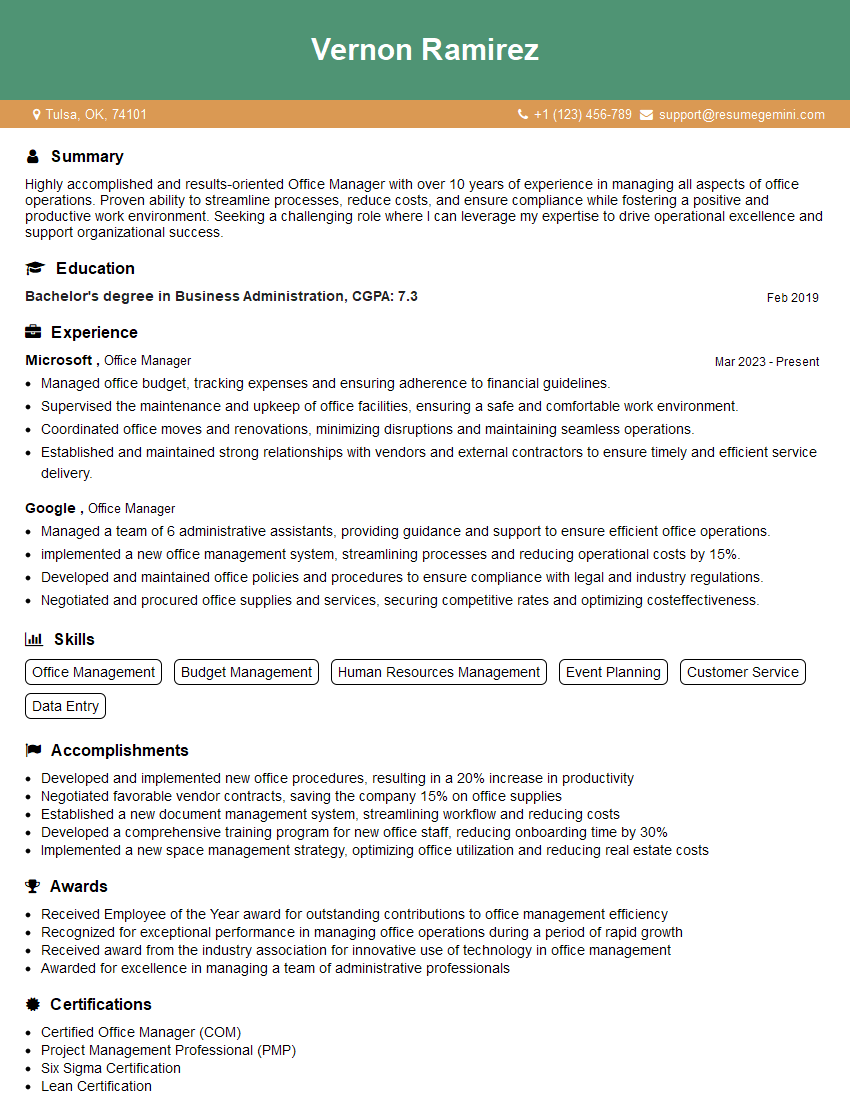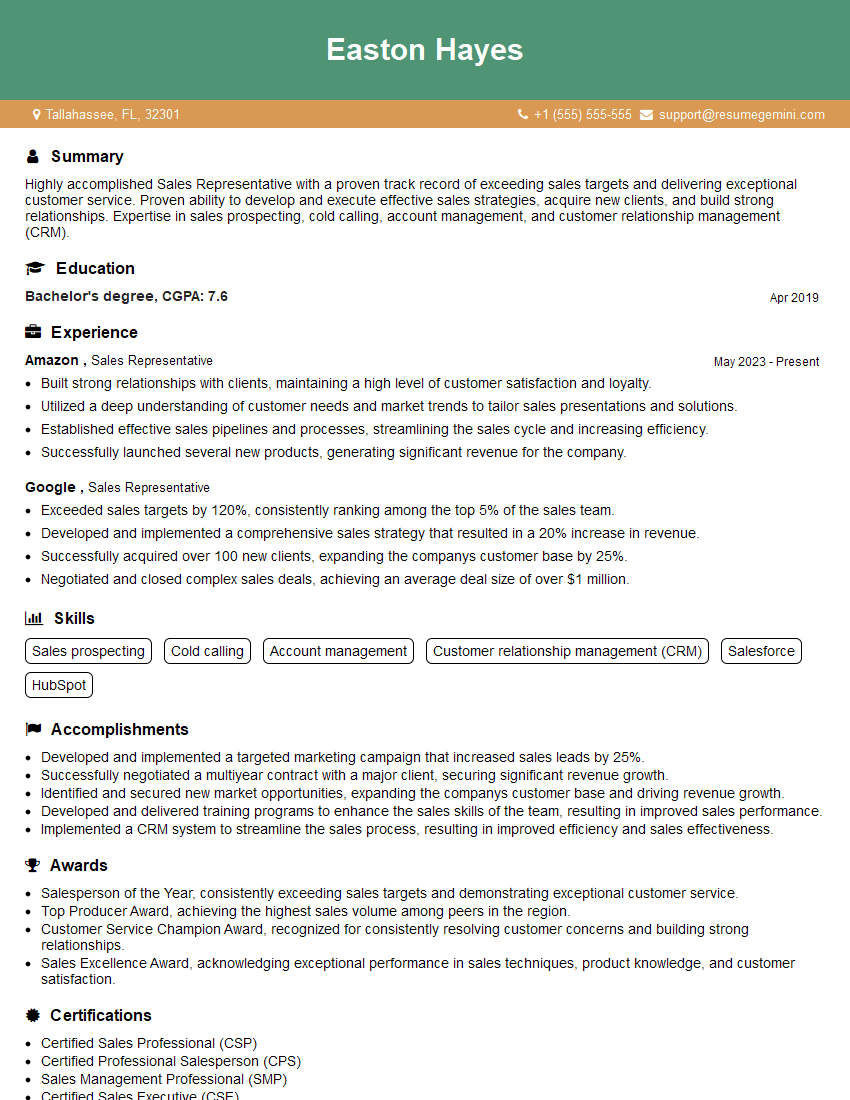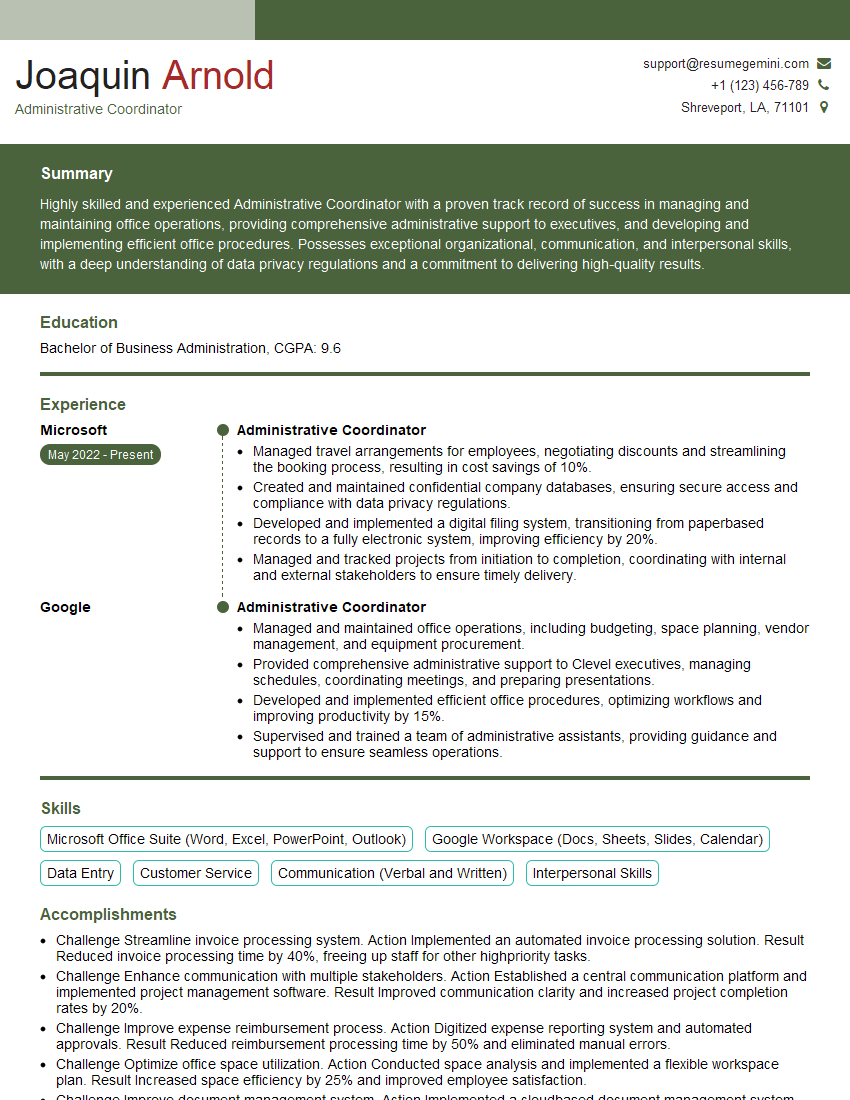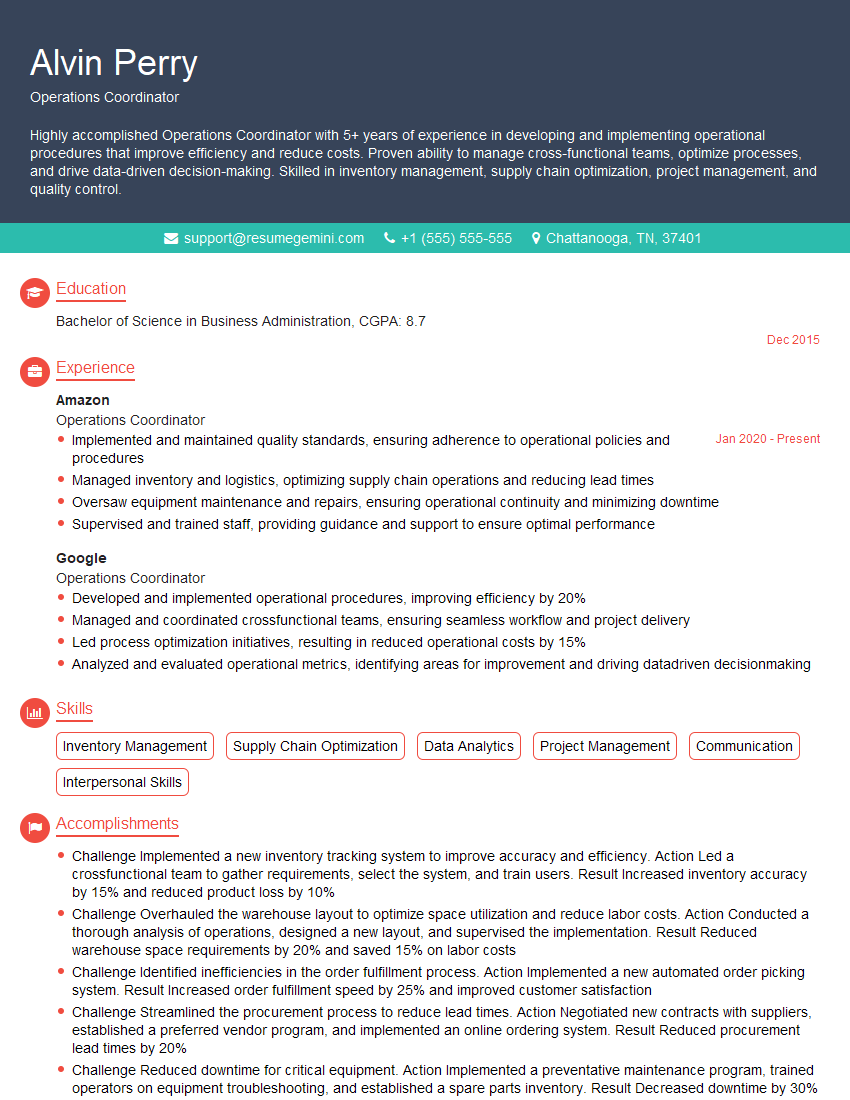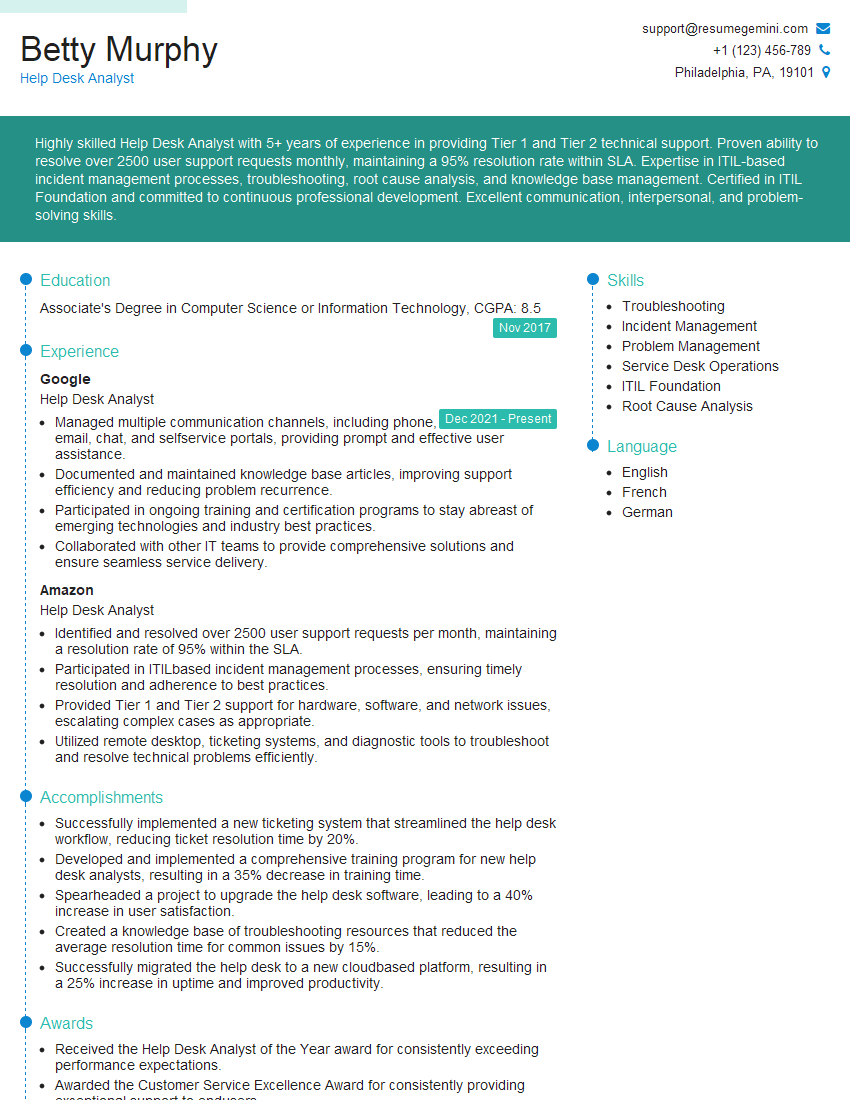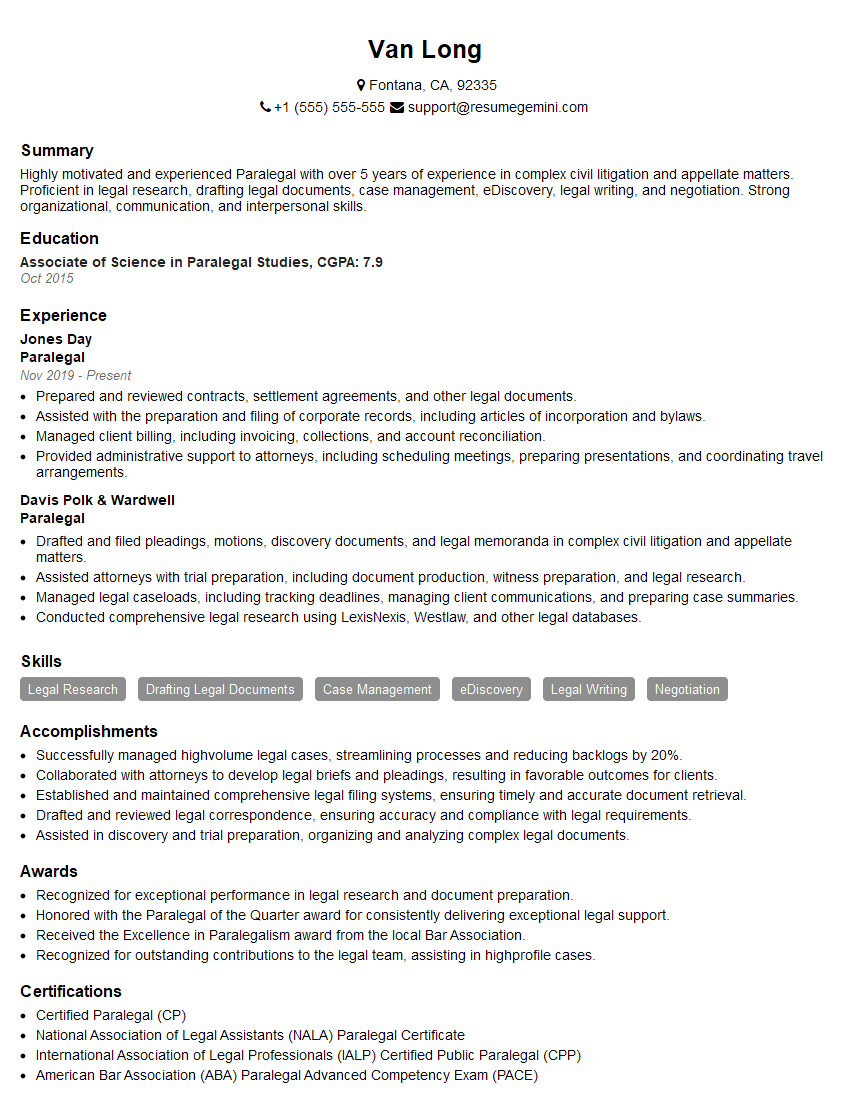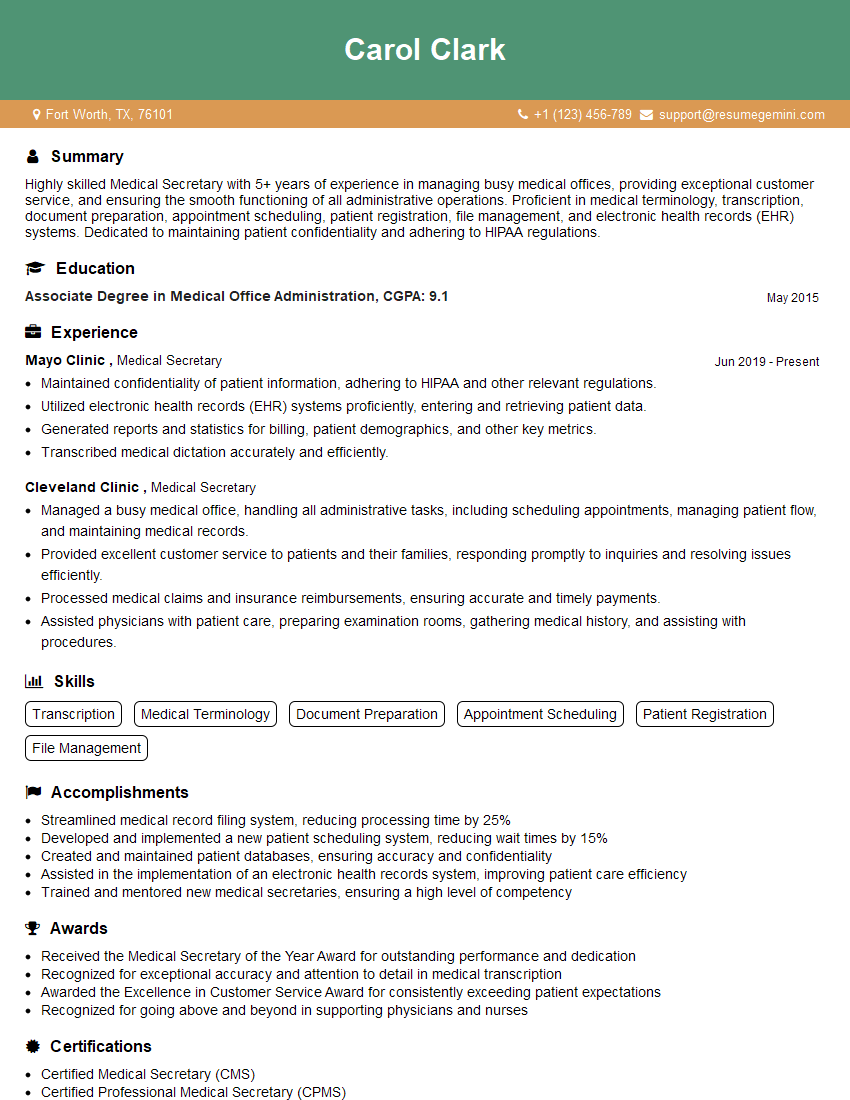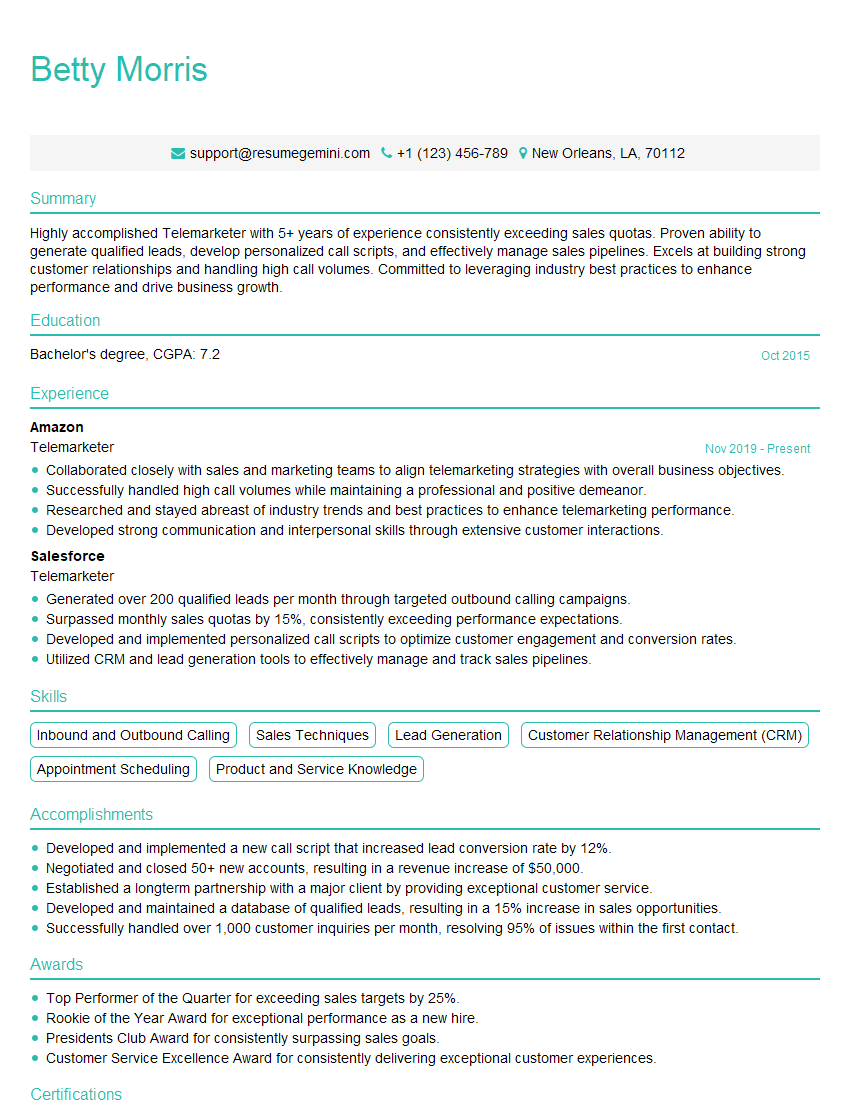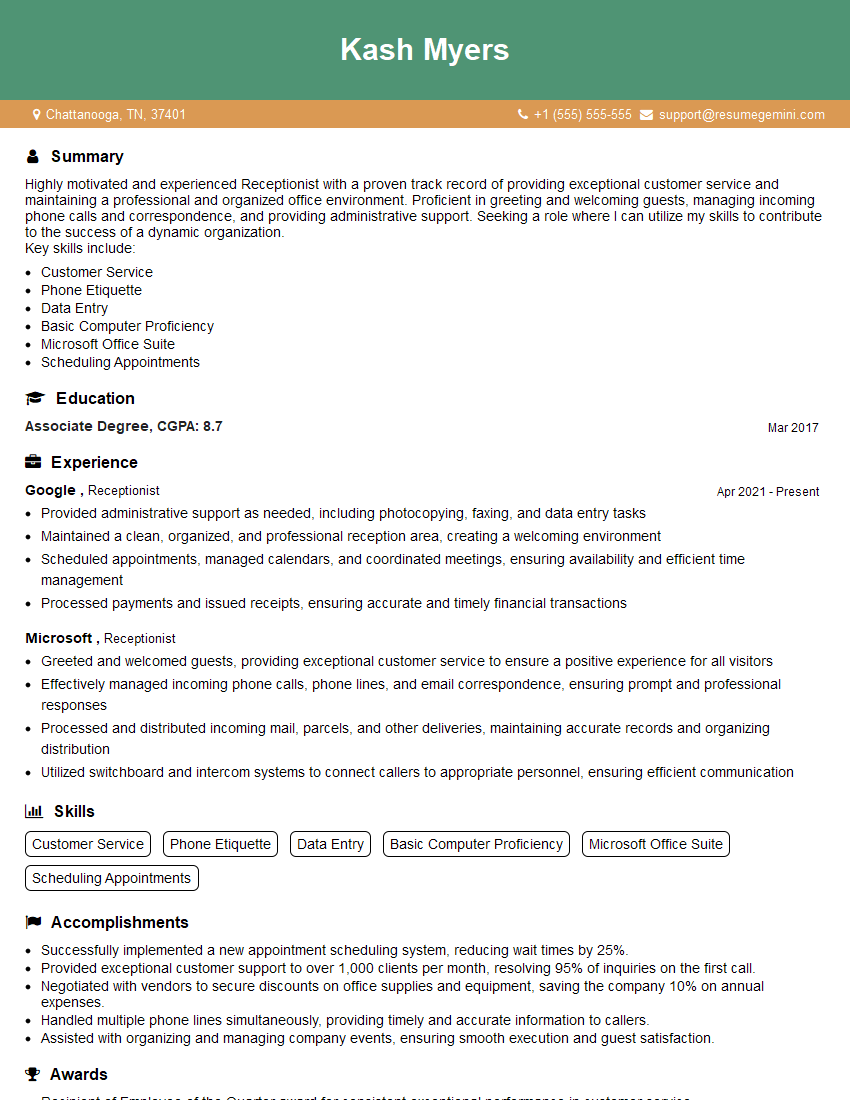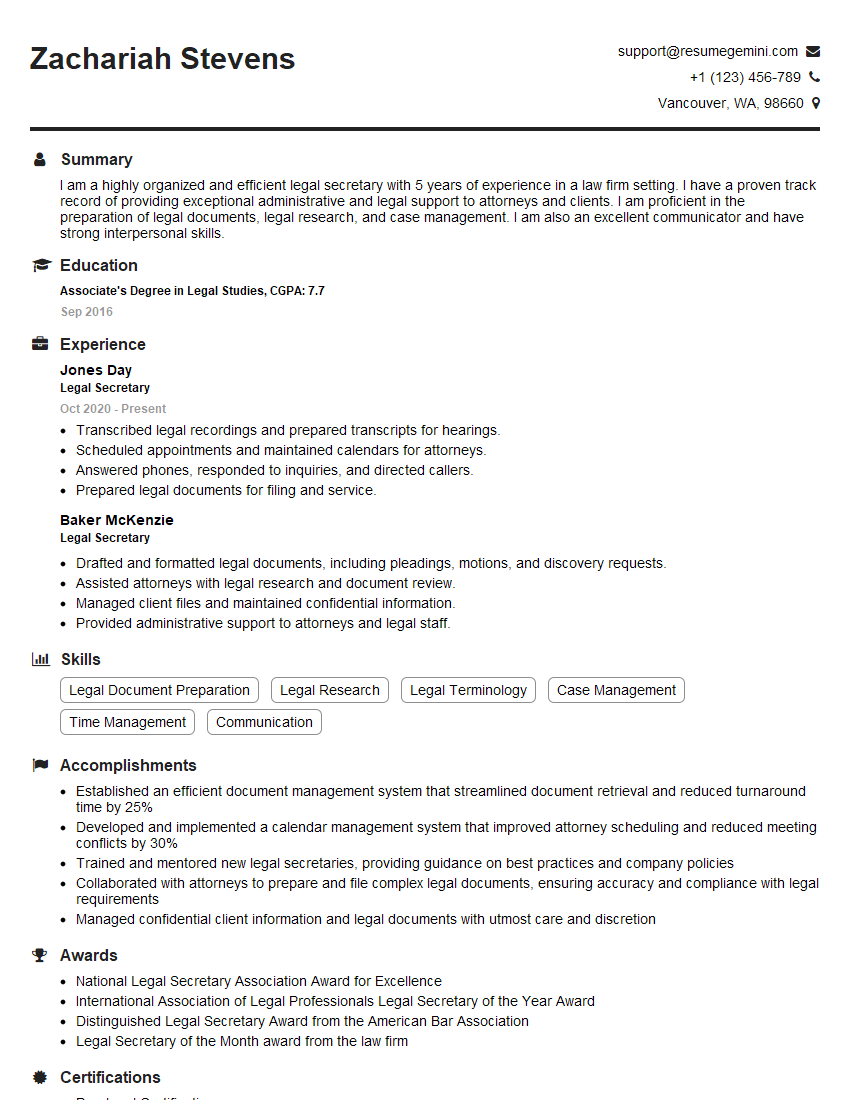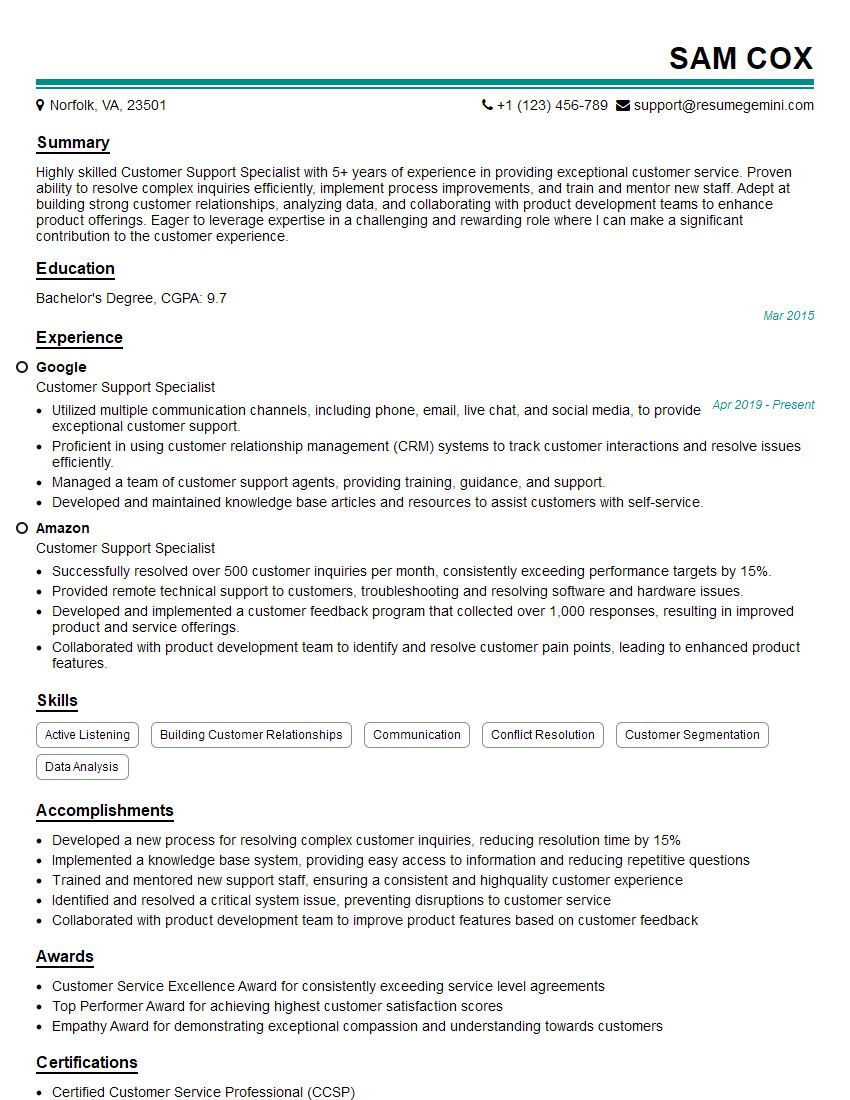Cracking a skill-specific interview, like one for Professional Phone Etiquette, requires understanding the nuances of the role. In this blog, we present the questions you’re most likely to encounter, along with insights into how to answer them effectively. Let’s ensure you’re ready to make a strong impression.
Questions Asked in Professional Phone Etiquette Interview
Q 1. How do you handle a call from an angry customer?
Handling an angry customer on the phone requires a calm, empathetic approach. The goal is to de-escalate the situation and find a resolution. Think of it like this: you’re a firefighter, not adding fuel to the flames.
- Listen actively and empathetically: Let the customer vent without interruption (unless it becomes abusive). Use phrases like, “I understand your frustration,” or “I can see why you’re upset.”
- Validate their feelings: Acknowledge their concerns, even if you don’t agree with their perspective. For example, “That sounds incredibly inconvenient, I’m sorry you’re experiencing this.”
- Take ownership (if applicable): If your company is at fault, own it. Apologize sincerely and avoid making excuses. A simple “I apologize for the inconvenience” can go a long way.
- Offer solutions: Present options to resolve the problem. Clearly explain the steps you’ll take and the timeframe for resolution.
- Maintain a calm and professional tone: Even if the customer is shouting, stay calm and speak slowly and clearly. Avoid getting defensive or argumentative.
- Document everything: After the call, document the details of the conversation, including the customer’s concerns, the steps taken, and the resolution offered.
Example: Imagine a customer calling, furious because their order is delayed. Instead of arguing, I might say, “I understand your frustration with the delay. Let me check the status of your order right now. It seems there was an unforeseen issue with shipping, but I can offer you a 10% discount on your next order as a token of apology, and I’ll expedite the shipping on your current order.”
Q 2. What is your strategy for leaving a professional voicemail message?
A professional voicemail message should be concise, clear, and informative. It’s your digital handshake; it should represent you and your company well.
- Identify yourself and your company: Start with your name and company. For example, “Hi, this is John Smith from Acme Corporation.”
- State the purpose of your call: Briefly explain why you’re calling. For instance, “I’m calling to follow up on our meeting,” or “I’m calling regarding your inquiry about…”
- Provide your contact information: Clearly state your phone number and email address.
- Suggest a time to call back: If appropriate, propose a specific time for a return call. For example, “Please call me back at your earliest convenience, or anytime after 2 PM today.”
- Keep it brief: Aim for a message under 30 seconds.
Example: “Hi, this is Sarah Jones from ABC Company. I’m calling to follow up on your application. Please call me back at 555-123-4567 or email me at [email protected] at your earliest convenience. Thank you.”
Q 3. Describe your process for screening calls and prioritizing urgent matters.
Effective call screening and prioritization are crucial for maximizing productivity. This involves understanding your role and company policies and leveraging tools at your disposal.
- Understand your company’s priorities: Knowing what’s urgent (e.g., customer complaints, sales leads, etc.) allows you to prioritize appropriately.
- Use a caller ID and voice mail system: These tools help identify and manage calls effectively. For example, you may use an auto-attendant system.
- Develop a screening script (if needed): A brief, polite script can quickly determine the urgency of a call. For example, “Thank you for calling Acme Corp. May I ask who’s calling and the reason for your call?”
- Prioritize based on urgency and importance: Use a system (e.g., first-in, first-out, or a priority matrix) to manage your calls efficiently.
- Take messages accurately: For non-urgent calls, take detailed messages ensuring you capture name, number, company, and nature of their inquiry.
Example: A call comes in. Using my caller ID, I see it’s a potential client. I answer professionally, identify myself, and use my screening script. If it’s a high-priority sales lead, I immediately connect them to the appropriate person. If it’s a non-urgent inquiry, I politely take a message.
Q 4. How do you ensure confidentiality during phone conversations?
Maintaining confidentiality during phone conversations is paramount, especially in professional settings. It’s about protecting sensitive information and upholding trust.
- Never discuss confidential information in public areas: Use a private office or cubicle when handling sensitive matters. Avoid using speakerphone in public spaces.
- Verify the caller’s identity before discussing sensitive details: Ask for relevant information to ensure they’re who they claim to be.
- Use discretion when discussing sensitive information: Avoid using specific names or details if not absolutely necessary.
- Be mindful of your surroundings: Ensure your background is free of potentially sensitive visual information.
- Follow company policies regarding data security and confidentiality: Adhere to all internal guidelines and regulations regarding the handling of sensitive information.
Example: When discussing a client’s financial information, I always verify their identity first and would avoid mentioning it if not directly related to the conversation’s purpose.
Q 5. What techniques do you use to actively listen during phone calls?
Active listening involves more than just hearing; it’s about fully understanding the message being conveyed. Imagine it as building a bridge of understanding.
- Pay attention to verbal and non-verbal cues: Even though you can’t see the caller, their tone of voice, pauses, and speed of speaking can provide valuable insights.
- Summarize and paraphrase: Periodically restate what you’ve heard to confirm your understanding. For example, “So, if I understand correctly, you’re saying…”
- Ask clarifying questions: Don’t hesitate to ask for clarification if something is unclear. For example, “Can you elaborate on that?”
- Avoid interrupting: Let the caller finish their thought before responding. Show patience and respect for their time.
- Focus on the conversation: Minimize distractions and give the caller your undivided attention.
Example: Instead of interrupting, I let a customer finish explaining their problem, then summarize, “It seems the issue is that you can’t access your online account due to a password problem.” This shows I’m actively listening and helps prevent misunderstandings.
Q 6. How do you verify the identity of a caller?
Verifying a caller’s identity is crucial, especially when dealing with sensitive information. It’s a vital part of secure communication.
- Ask for identifying information: Depending on the sensitivity of the information, this may include name, account number, date of birth, or other relevant data. Always have a clear protocol for this, aligned with your company’s security policies.
- Consult internal databases or systems: Verify the information provided against your company’s records to confirm the caller’s identity. This could involve accessing CRM systems, account management databases, or similar tools.
- Use security protocols as needed: For highly sensitive information, using security questions or multi-factor authentication might be necessary.
- Be cautious of phishing attempts: Be wary of callers who seem overly eager to provide personal information.
- Document verification steps: Maintain a record of the verification process, including the information obtained and the verification methods used. This is crucial for auditing and security purposes.
Example: If a caller claims to be a client seeking to update their personal information, I might ask for their account number and date of birth before proceeding. Then, I would verify this information against my company’s database before sharing any sensitive details.
Q 7. How would you handle a call where you’re unsure of the answer to a question?
Handling a call where you’re unsure of the answer requires honesty and a proactive approach. It is better to admit a lack of knowledge than to provide incorrect information.
- Acknowledge that you don’t know the answer: Be upfront and honest with the caller. Say something like, “I don’t have the answer to that question right now, but I’ll find out for you.”
- Take down relevant information: Get the caller’s contact information and the details of their question to aid your research.
- Find the answer: Use available resources (e.g., manuals, databases, colleagues) to get the correct answer.
- Get back to the caller promptly: Contact the caller within a reasonable timeframe (e.g., within the same day or by the next business day) with the answer to their question.
- Maintain professionalism: Express your commitment to providing accurate information and show appreciation for the caller’s patience.
Example: If a caller asks a technical question about a product, I might say, “I’m not familiar with the specifics of that feature, but I can connect you with our technical support team who can assist you. Or, I can find the information in our technical manuals and call you back with the answer by the end of the day.”
Q 8. How do you handle multiple phone calls simultaneously?
Handling multiple calls simultaneously requires a strategic approach prioritizing efficiency and professionalism. The key is to quickly assess the urgency of each call and manage them effectively.
- Prioritization: If one call is clearly urgent (e.g., a crisis situation), I would politely ask the other caller to hold briefly while addressing the urgent matter. I might say, “Thank you for calling. I have another urgent call I need to take quickly; may I put you on a brief hold?”
- Call Waiting Features: Proficient use of call waiting and call forwarding features is essential. I would utilize these to manage calls without dropping any.
- Quick Responses: For less urgent calls, I aim for concise and efficient communication to minimize hold times. I might use phrases like, “I’m currently on another call, but can address your inquiry within [timeframe].”
- Taking Messages: If unable to assist immediately, I accurately record the caller’s name, number, and reason for calling, ensuring follow-up.
Think of it like a skilled conductor leading an orchestra; each instrument (call) needs attention, but the conductor ensures harmony and prevents chaos.
Q 9. What is your approach to transferring calls to the appropriate person?
Transferring calls efficiently and professionally is crucial for maintaining a positive caller experience. My approach involves several steps:
- Confirm Information: Before transferring, I verify the caller’s need and the appropriate recipient. I might say, “To ensure I connect you to the right person, could you please confirm the nature of your inquiry?”
- Prepare Recipient: If possible, I briefly inform the recipient of the caller’s name and reason for the call, allowing them to gather necessary information beforehand. This prevents unnecessary repetition and makes the transfer smoother.
- Transfer the Call: I utilize the appropriate transfer method (blind or consult) depending on the situation. A blind transfer connects the caller directly, while a consult allows me to speak with the recipient before connecting the call ensuring they are available and prepared.
- Follow Up: After the transfer, if necessary, I’ll follow up with both parties to confirm successful connection and resolution.
A smooth transfer is like seamlessly passing a baton in a relay race – ensuring the conversation continues without interruption or confusion.
Q 10. How do you politely end a phone conversation?
Ending a phone conversation politely is vital for leaving a positive last impression. It’s more than just saying goodbye.
- Summarize Key Points: Briefly recap the main points discussed, confirming understanding and preventing future misunderstandings. For example, “Just to confirm, we agreed to…”
- Express Appreciation: Express gratitude for the caller’s time, for example, “Thank you for calling and taking the time to discuss this.”
- Offer Assistance: If appropriate, offer further assistance if needed, such as, “Please don’t hesitate to contact me if you have any further questions.”
- Formal Closing: Use a professional closing remark such as, “Have a great day!” or “Thank you for calling; goodbye.”
Ending a call gracefully is like concluding a formal meeting – it leaves a lasting sense of professionalism and courtesy.
Q 11. How do you maintain a professional tone of voice while on the phone?
Maintaining a professional tone requires conscious effort and self-awareness. Here’s how I approach it:
- Enthusiasm and Respect: Start with a welcoming and upbeat tone. Speak clearly and respectfully, regardless of the caller’s demeanor.
- Active Listening: Pay close attention to what the caller is saying. This helps maintain engagement and convey genuine interest.
- Clear Articulation: Speak at a moderate pace, clearly enunciating words. Avoid slang, jargon, and excessive interruptions.
- Emotional Control: Maintain composure even during challenging calls. If frustrated, I take a moment to collect my thoughts before responding.
- Body Language: While on the phone, good posture and a positive attitude can impact your tone.
Think of your voice as a brand ambassador; a positive tone reflects positively on the company.
Q 12. How do you adapt your communication style to different types of callers?
Adapting to different callers involves understanding various communication styles and adjusting accordingly.
- Identify Caller Type: Quickly assess the caller’s personality and communication style (e.g., direct, formal, informal).
- Adjust Language and Tone: Use language appropriate to the caller. For example, I might use more formal language with a senior executive compared to a more casual tone with a long-standing client.
- Pace and Detail: Tailor the pace and level of detail to the caller’s needs and preferences. Someone in a hurry requires concise answers; others might need more explanation.
- Empathy: Show empathy and understanding towards the caller’s situation, regardless of their demeanor.
Like a chameleon adapting to its environment, I adjust my communication to ensure clear and effective understanding.
Q 13. What technology are you proficient with for managing phone calls and communications?
I am proficient with a range of technologies for managing phone calls and communication:
- Phone Systems (PBX): Experienced with various PBX systems, including features like call queuing, call routing, voicemail, and conference calling.
- CRM Software: Proficient in using CRM systems (e.g., Salesforce, HubSpot) to manage customer interactions and track call history.
- Unified Communications Platforms: Familiar with platforms that integrate voice, video, messaging, and presence information for seamless communication.
- Call Recording and Monitoring Software: Experienced in using software for call recording (for training and quality assurance purposes) and call monitoring (for supervision).
- VoIP Technology: Understanding of Voice over Internet Protocol (VoIP) systems and their advantages.
Technology is a tool; my expertise lies in using it effectively to enhance communication, not replace human interaction.
Q 14. How do you handle calls outside of your regular working hours?
Handling calls outside of regular working hours requires a clear policy and a professional approach.
- Clear Expectations: It’s important to set clear expectations with colleagues and clients regarding after-hours availability. If after-hours support is offered, it should be clearly communicated.
- Voicemail: An informative and professional voicemail message should be set, providing contact information for urgent matters and outlining when to expect a response.
- On-Call Rotation: If on-call support is required, a fair and well-defined rotation schedule should be in place to ensure no individual is overburdened.
- Urgent vs. Non-Urgent: Prioritize urgent calls (e.g., emergencies) over non-urgent requests, offering a timeframe for response to non-urgent calls.
Handling after-hours calls demonstrates commitment and professionalism while also maintaining a healthy work-life balance.
Q 15. Describe your experience using phone systems such as VoIP or PBX.
My experience with VoIP and PBX phone systems is extensive. I’ve worked with several platforms, including Asterisk, Cisco CallManager, and various cloud-based VoIP solutions. I’m comfortable navigating different interfaces, managing call queues, utilizing call forwarding features, and troubleshooting basic system issues. For example, in a previous role, I successfully identified and resolved a recurring problem with dropped calls on our VoIP system by coordinating with IT to update the network infrastructure. With PBX systems, I’m familiar with handling internal transfers, voicemail management, and configuring auto-attendants to optimize call routing efficiency. This expertise allows me to effectively manage incoming and outgoing calls, ensuring a seamless communication flow.
Career Expert Tips:
- Ace those interviews! Prepare effectively by reviewing the Top 50 Most Common Interview Questions on ResumeGemini.
- Navigate your job search with confidence! Explore a wide range of Career Tips on ResumeGemini. Learn about common challenges and recommendations to overcome them.
- Craft the perfect resume! Master the Art of Resume Writing with ResumeGemini’s guide. Showcase your unique qualifications and achievements effectively.
- Don’t miss out on holiday savings! Build your dream resume with ResumeGemini’s ATS optimized templates.
Q 16. How do you document important information from phone calls?
Documenting important information from phone calls is crucial for maintaining accurate records and ensuring follow-up. My process involves utilizing a combination of methods depending on the context. For routine calls, I often use a CRM system to create detailed notes, including the caller’s name, contact information, the purpose of the call, any agreements or action items, and the date and time. For more complex or critical calls, I create a formal memo summarizing all relevant details. This ensures that no crucial information is lost and facilitates easy access for future reference. For example, in a client-facing role, I consistently documented client concerns and resolution steps, maintaining a transparent and well-organized record for ongoing management.
Q 17. How do you ensure accuracy when taking messages?
Ensuring accuracy when taking messages is paramount. My approach is threefold: First, I verify all information with the caller. I politely repeat names, numbers, and key details back to them to confirm accuracy. Second, I use clear and concise language when recording messages. I avoid ambiguity and use complete sentences to minimize misinterpretations. Third, I always clarify any unclear information. If something is confusing or I am unsure about a particular detail, I actively ask the caller for clarification to ensure nothing is missed or misinterpreted. Imagine taking a message for a doctor’s appointment – an incorrect time or date could have serious consequences.
Q 18. Explain your process for dealing with missed calls.
My process for dealing with missed calls involves promptly returning them. I prioritize calls based on urgency and importance. If the caller ID provides context, I might prioritize that call based on my knowledge of the caller. I usually return calls within the hour if possible, or certainly within the business day. When returning a missed call, I always identify myself and the reason for the call, showing that I’ve reviewed their call log or any notes. For example, if a client called with an urgent issue, that would be my top priority to return quickly.
Q 19. How do you handle a call from someone who is speaking very quickly?
When dealing with a caller speaking very quickly, I politely but firmly interject. I might say something like, “Excuse me, could you please slow down just a bit? I want to make sure I understand everything you’re saying.” If necessary, I might ask them to repeat certain parts of their message or summarize their key points. Maintaining a calm and respectful tone is crucial; it’s more effective to guide the conversation than to appear flustered. Think of it like a musician conducting an orchestra – you need to guide the tempo for harmonious communication.
Q 20. How do you handle a call where the caller is speaking another language?
Handling calls in other languages requires a thoughtful approach. If I understand the language, I proceed naturally. If not, I’ll politely ask if they speak English, or if not, if they would prefer using a translation service or finding a colleague who speaks their language. If using a translation service, I would use a reliable and professional one to minimize misunderstandings. It’s crucial to be respectful and understanding, recognizing the language barrier as a potential communication challenge. It might be helpful to have a list of bilingual colleagues and their language skills, or to have access to a translator app. The goal is to provide the best possible service despite the language difference.
Q 21. How do you handle background noise or interruptions during a phone call?
Background noise and interruptions are common challenges. My approach is to address them directly and professionally. If there’s significant background noise, I’ll politely say something like, “I’m experiencing some background noise on my end. Could you please hold for a moment while I find a quieter location?” If interrupted, I’ll briefly pause and then politely resume the conversation. For example, I might say, “Excuse me for the interruption, where were we?” It’s about maintaining composure and ensuring the caller feels heard despite the distractions. Maintaining professionalism and showing consideration for both yourself and the caller is key.
Q 22. What strategies do you employ to prevent miscommunication over the phone?
Preventing miscommunication on the phone requires a multi-pronged approach focusing on clarity, confirmation, and active listening. It’s like building a sturdy bridge – each element is crucial for a successful crossing.
Clear and Concise Language: Avoid jargon and ambiguous terms. Speak slowly and deliberately, enunciating clearly. Imagine explaining a complex concept to someone who’s never heard it before. This ensures your message is easily understood.
Active Listening: Pay close attention to what the other person is saying. Don’t interrupt, and summarize their points to confirm your understanding. For example, you might say, “So, to recap, you’re experiencing issues with the login process, specifically the password reset feature?”
Confirmation and Repetition: Repeat crucial information back to the caller to ensure accuracy. For instance, if they provide an order number, repeat it back to them, “Okay, I have order number 12345, is that correct?” This simple step avoids costly errors.
Appropriate Tone: Maintain a professional and courteous tone throughout the conversation, even if the caller is upset. Your tone conveys as much as your words.
Document Everything: After the call, make detailed notes about the conversation, including key decisions and action items. This creates a record for future reference and prevents misunderstandings.
Q 23. How do you use phone communication to build rapport with clients or customers?
Building rapport over the phone involves creating a connection with the client by focusing on empathy, professionalism, and personalization. Think of it as a virtual handshake, warm and welcoming.
Personalized Greeting: Start by using the client’s name and addressing them respectfully. A simple “Good morning, Mr. Smith,” goes a long way.
Empathetic Listening: Actively listen to their concerns and show genuine understanding. Reflect their feelings by saying things like, “I understand this is frustrating,” or “I can see why you’d be concerned about that.”
Professional Tone: Maintain a calm and respectful demeanor throughout the conversation, regardless of the client’s tone. Model the behavior you’d like to see.
Clear and Concise Communication: Avoid technical jargon and explain things in simple terms. Use analogies or metaphors to illustrate complex concepts.
Follow-Up: After the call, send a brief email summarizing the discussion and outlining next steps. This shows attentiveness and professionalism.
Q 24. Describe a situation where excellent phone etiquette made a positive impact.
I once had a situation where a highly frustrated client was calling to complain about a delayed shipment. He was extremely agitated and bordering on aggressive. Instead of getting defensive, I actively listened to his concerns, validated his feelings, and apologized for the inconvenience. I calmly explained the reasons for the delay and offered a solution – expedited shipping at no extra cost. By remaining calm, empathetic, and proactive, I turned a potentially negative situation into a positive one. The client was incredibly appreciative of my understanding and the solution provided. He ended up becoming a repeat customer and even recommended our services to his colleagues.
Q 25. How do you stay calm and professional under pressure while on the phone?
Staying calm and professional under pressure on the phone requires preparation, practice, and self-regulation. It’s like being a firefighter – you need the right tools and the right mindset.
Deep Breathing: Take slow, deep breaths to center yourself before responding to an agitated caller. This helps regulate your heart rate and calm your nerves.
Positive Self-Talk: Remind yourself of your skills and your ability to handle the situation. This internal dialogue can make a big difference.
Active Listening: Focus on understanding the caller’s perspective. This often defuses tension.
Reframing the Situation: View the call as an opportunity to demonstrate your problem-solving skills and build a stronger client relationship.
Pause Before Responding: Don’t feel pressured to respond immediately. Take a moment to collect your thoughts before answering.
Q 26. What are some common mistakes people make in professional phone etiquette?
Common mistakes in professional phone etiquette include:
Answering the phone without a professional greeting: Failing to identify yourself and your company creates a bad first impression.
Multitasking while on the phone: This leads to inattentiveness and missed information. It’s like trying to read a book and drive a car at the same time; neither task is done well.
Using unprofessional language or tone: This can alienate callers and damage your reputation.
Interrupting callers: This is rude and shows a lack of respect for their time.
Failing to follow up: Neglecting to return calls or provide updates leaves a negative impression.
Putting callers on hold without explanation or for too long: This displays a lack of consideration.
Q 27. How do you prioritize multiple phone calls with varying levels of urgency?
Prioritizing multiple phone calls requires a structured approach, like a triage system in a hospital emergency room. The most urgent calls need immediate attention.
Urgent Calls First: Address calls requiring immediate action, such as a client facing a critical issue or an emergency situation.
Time-Sensitive Calls Next: Handle calls with deadlines or important time constraints.
Routine Calls: Address less urgent calls after the time-sensitive ones.
Call-Backs: If you’re unable to answer a call immediately, return it as soon as possible with an explanation for the delay.
Use Technology: Utilize call management software to help queue and prioritize incoming calls.
Q 28. Describe your experience with using call recording software or systems.
I have extensive experience with call recording software, primarily using systems that comply with all relevant data privacy regulations. These systems offer valuable benefits, but also require careful management to ensure compliance.
Legal and Ethical Considerations: Before using call recording software, it’s essential to be aware of and comply with all applicable laws and regulations regarding data privacy and consent. This often involves obtaining explicit consent from the caller before recording.
Data Security and Storage: The software should provide secure data storage and encryption to protect sensitive information.
Training and Usage: Proper training for employees on the appropriate use and limitations of call recording is vital.
Practical Applications: Call recordings can be beneficial for training, quality assurance, dispute resolution, and performance improvement. They offer a valuable record of interactions and can be used to identify areas for improvement.
Key Topics to Learn for Professional Phone Etiquette Interview
- First Impressions: Mastering the initial greeting and creating a positive tone. Practical application: Practice your opening line, ensuring it’s clear, concise, and professional.
- Active Listening & Engagement: Demonstrating attentiveness and understanding throughout the conversation. Practical application: Utilize verbal and nonverbal cues (like saying “uh-huh” or “I understand”) to show engagement.
- Clear & Concise Communication: Articulating your thoughts effectively and avoiding jargon. Practical application: Prepare concise answers to anticipated questions, practicing your delivery.
- Professional Tone & Language: Maintaining a respectful and courteous demeanor throughout the call. Practical application: Avoid slang, filler words (“um,” “like”), and overly casual language.
- Handling Interruptions & Difficult Situations: Gracefully managing unexpected interruptions or challenging questions. Practical application: Practice responses to potential disruptions, such as a sudden noise or a dropped call.
- Appropriate Call Length & Closing: Knowing when to begin and end a call professionally. Practical application: Prepare a concise summary and a professional closing statement for each call.
- Technology & Equipment: Ensuring your phone and environment are optimized for a professional call. Practical application: Test your microphone and speaker before any important calls, ensuring a quiet and distraction-free environment.
- Follow-Up Communication: Knowing how and when to send a thank-you note or email after a phone call. Practical application: Plan a timely and professional follow-up message.
Next Steps
Mastering professional phone etiquette is crucial for career advancement. A strong phone presence demonstrates professionalism, communication skills, and overall competence, significantly impacting your interview success and future job prospects. To further enhance your job search, focus on creating an ATS-friendly resume that highlights your relevant skills and experience. ResumeGemini is a trusted resource to help you build a compelling and effective resume. We provide examples of resumes tailored to showcase strong professional phone etiquette skills; utilize these resources to create a resume that will get noticed.
Explore more articles
Users Rating of Our Blogs
Share Your Experience
We value your feedback! Please rate our content and share your thoughts (optional).
What Readers Say About Our Blog
Hi, I’m Jay, we have a few potential clients that are interested in your services, thought you might be a good fit. I’d love to talk about the details, when do you have time to talk?
Best,
Jay
Founder | CEO
